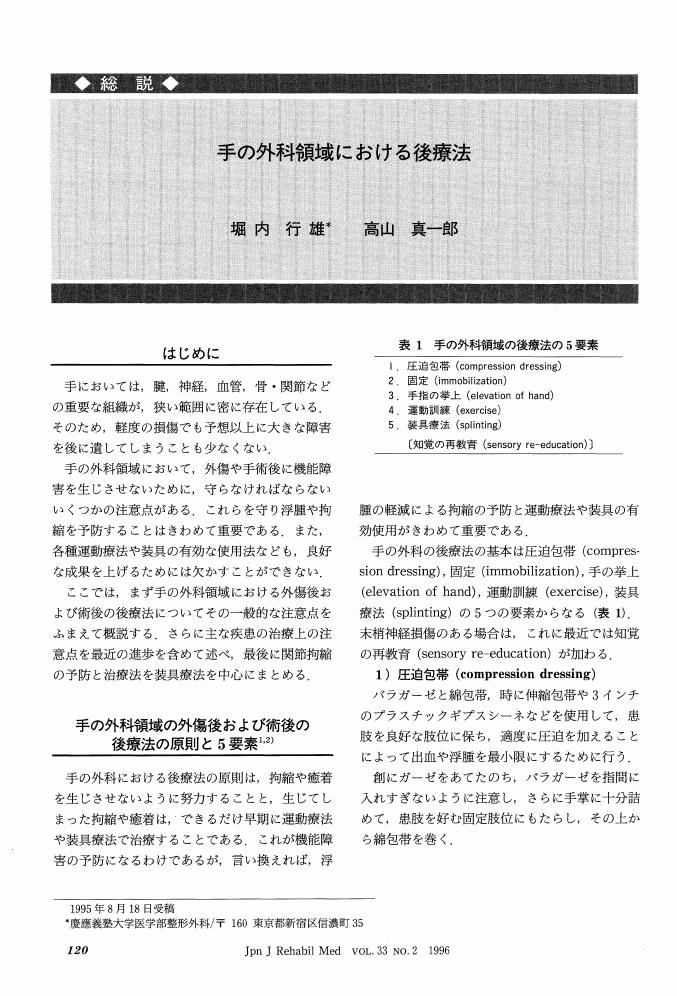1 0 0 0 OA パーキンソン病におけるすくみ足と両下肢協調運動障害
- 著者
- 阿部 和夫
- 出版者
- 社団法人 日本リハビリテーション医学会
- 雑誌
- リハビリテーション医学 (ISSN:0034351X)
- 巻号頁・発行日
- vol.43, no.5, pp.315-321, 2006 (Released:2006-05-23)
- 参考文献数
- 40
- 被引用文献数
- 1
Freezing of gait is observed in quiet a few neurological diseases but has been raised a main and disabling neurological sign in Parkinson's disease (PD). In this mini-review, studies concerning freezing of gait in PD are reviewed and a hypothesis that the freezing of gait phenomenon in PD originates from interlimb incoordination are introduced. Pathogenesis of the freezing of gait phenomenon remains unknown, but some hypotheses have been raised : (1) Rhythmical contraction of anterior tibial muscles are prohibited, (2) Postural changes to initiate gait are disturbed, (3) Reciprocal inhibition in the spinal cord is disturbed due to abnormal descending commands from the central nervous system. Based on experiments conducted using a special type of ergometer (strength ergo 240W), Abe et al observed interlimb incoordination in PD patients with freezing of gait during pedaling. In addition, Plotnik et al. observed asymmetrical lower limb movements during walking and considered that PD patients with freezing of gait might have interlimb incoordination. These studies may support a hypothesis that freezing of gait in PD originates from interlimb incoordination.
1 0 0 0 OA 経口蛋白同化ホルモンの神経系疾患患者における下肢筋力増強および筋肥大への効果
- 著者
- 横山 知子 鶴川 俊洋 川平 和美 田中 信行
- 出版者
- 社団法人 日本リハビリテーション医学会
- 雑誌
- リハビリテーション医学 (ISSN:0034351X)
- 巻号頁・発行日
- vol.36, no.6, pp.399-404, 1999-06-18 (Released:2009-10-28)
- 参考文献数
- 16
- 被引用文献数
- 2 2
脳卒中を中心とした神経系疾患患者25例を対象として,8週間の運動訓練のみを行った群(通常のリハ訓練+サイベックスを使用した膝の屈伸運動)と,4~8週目に蛋白同化ホルモン(オキシメトロン10あるいは20mg/日を内服)を併用した群の2群に無作為に分けて,非麻痺側下肢の筋力及び筋肥大に対する蛋白同化ホルモンの効果を検討した.下肢の運動訓練は両群ともサイベックス6000を用いて,座位で等速性(60°あるいは180°/秒)の膝屈伸運動を,適宜休憩を入れながら,1日100~200回,週5日,8週間行わせた.蛋白同化ホルモン併用群では,非投与時に比べて等速性筋力は低速度・高速度ともに,また伸筋,屈筋とも筋力の増加は有意に大きかった.等尺性筋力も伸筋,屈筋ともに増加し,またCT上での大腿筋断面積も有意に増加していた.一方,筋力トレーニング単独群では,全般的に筋力の増加傾向は認められたが,ほとんどの場合で有意ではなく,大腿断面積も明らかな増加を認めなかった.副作用として,AST,ALTの上昇がAS併用した13例中5例,Kの上昇を2例に認めたが,全例で薬剤中止後,正常に戻った.
1 0 0 0 OA 脳性麻痺の長期予後予測
- 著者
- 横関 仁 中島 雅之輔 中村 純人 藤本 輝世子
- 出版者
- 社団法人 日本リハビリテーション医学会
- 雑誌
- リハビリテーション医学 (ISSN:0034351X)
- 巻号頁・発行日
- vol.34, no.5, pp.337-341, 1997-05-18 (Released:2009-10-28)
- 参考文献数
- 8
我々は15年以上フォローアップし,現在18歳以上の脳性麻痺患者264例(男179例,女85例)の周生期危険因子,療育期間の健康状態,原始反射の推移,各種運動機能の出現時期,IQ,てんかんの有無,股関節脱臼・側弯症等の変形の有無,整形外科手術の有無など50項目を調査した.これらに数量化II類による多変量解析を行うことによって,成人期の移動,独歩,経済的自立の可否の予測がどの程度まで可能となるかを分析した.移動能力の獲得に関しては肘立て,寝返り,首すわりの完成時期と側弯発生時期,幼児期の健康の評価により,90%以上の確率で予測可能であった.独歩の獲得に関しては,四つ這い,首すわり完成時期と麻痺領域,幼児期のIQの評価を行うことにより,80%以上の確率で予測可能であった.経済的自立能力の獲得に関しては,歩行開始時期,幼児期のIQ,麻痺領域,肘立て完成時期,首すわり完成時期を評価することにより,80%以上の確率で予測可能であった.
1 0 0 0 OA 筋音図法の概要
- 著者
- 三田 勝己
- 出版者
- 社団法人 日本リハビリテーション医学会
- 雑誌
- リハビリテーション医学 (ISSN:0034351X)
- 巻号頁・発行日
- vol.40, no.11, pp.750-756, 2003-11-18 (Released:2009-10-28)
- 参考文献数
- 10
- 被引用文献数
- 2
1 0 0 0 OA 手の外科領域における後療法
- 著者
- 堀内 行雄 高山 真一郎
- 出版者
- 社団法人 日本リハビリテーション医学会
- 雑誌
- リハビリテーション医学 (ISSN:0034351X)
- 巻号頁・発行日
- vol.33, no.2, pp.120-128, 1996-02-18 (Released:2009-10-28)
- 参考文献数
- 17
1 0 0 0 OA 新しい褥瘡の概念とリハビリテーション
- 著者
- 大浦 武彦
- 出版者
- 社団法人 日本リハビリテーション医学会
- 雑誌
- リハビリテーション医学 (ISSN:0034351X)
- 巻号頁・発行日
- vol.41, no.5, pp.286-291, 2004-05-18 (Released:2009-10-28)
- 参考文献数
- 8
1 0 0 0 OA リハビリテーション診療に求められる臨床心理業務担当者に関するアンケート調査結果
- 出版者
- 社団法人 日本リハビリテーション医学会
- 雑誌
- リハビリテーション医学 (ISSN:0034351X)
- 巻号頁・発行日
- vol.43, no.12, pp.808-813, 2006-12-18 (Released:2009-09-15)
- 参考文献数
- 6
1 0 0 0 OA 介護保険制度による改修サービスの追跡調査
- 著者
- 上村 智子
- 出版者
- 社団法人 日本リハビリテーション医学会
- 雑誌
- リハビリテーション医学 (ISSN:0034351X)
- 巻号頁・発行日
- vol.42, no.10, pp.714-720, 2005 (Released:2006-09-22)
- 参考文献数
- 20
- 被引用文献数
- 3 4
介護保険制度による改修サービスの課題を検討するために追跡調査を行った. 2002年度広島県三原市の改修申請者88名 (77.4±8.9歳, 女性61名・男性27名) を対象とした. 2002年度全申請者から死亡者39名と転居者7名を除く323名に調査を依頼した (承諾率27%). 改修541±120日後に利用者宅で実施した. 15名 (17%) が, 改修したトイレ・浴室・外出口いずれかの使用を6カ月以内に中断した. 3件は屋内で車いすを使うための改修であり, 改修直後に使用が中断された. 12件は段差解消以外の改修であり, 利用者の心身機能低下後に中断された. 認知障害者の改修設備の6カ月以内の使用中断のオッズ比は, 障害なしの者より高かった (p = 0.001). 車いす導入改修と認知症高齢者の改修の課題が明らかになった.
1 0 0 0 OA 失語症非訓練例の回復について
- 著者
- 前島 伸一郎 種村 純 重野 幸次 長谷川 恒雄 馬場 尊 今津 有美子 梶原 敏夫 土肥 信之
- 出版者
- 社団法人 日本リハビリテーション医学会
- 雑誌
- リハビリテーション医学 (ISSN:0034351X)
- 巻号頁・発行日
- vol.29, no.2, pp.123-130, 1992-02-18 (Released:2009-10-28)
- 参考文献数
- 22
- 被引用文献数
- 3 2 5
言語訓練をうけることができなかった脳血管障害による失語症患者30例を対象に,失語症状の自然経過を経時的に評価し,年齢,性,原因疾患,失語症タイプ等との関係を検討した,言語理解は,健忘型で3ヵ月まで改善を認め,他のタイプでは6ヵ月以降にも改善を認めた.発話は,健忘型で3ヵ月まで,表出型,受容型では6ヵ月以降にも改善を認めた.表出-受容型は初期よりほとんど改善を認めなかった.書字は表出-受容型を除くすべてのタイプで3~6ヵ月以降にも改善を認めたが,表出-受容型では初期より改善を認めなかった.重度の失語症では,非訓練例は訓練例のような改善を認めないため,体系的な言語訓練が必要と思われた.
1 0 0 0 OA リハビリテーションにおけるリスクマネージメント
- 出版者
- 社団法人 日本リハビリテーション医学会
- 雑誌
- リハビリテーション医学 (ISSN:0034351X)
- 巻号頁・発行日
- vol.43, no.3, pp.149-179, 2006-03-18 (Released:2010-02-10)
リハビリテーション医の立場から—全国実態調査の概要と安全管理ガイドライン作成に向けての取り組み—…里宇 明元 149リハビリテーション看護の立場から…北代 直美 155理学療法におけるリスクマネージメント…遠藤 敏 159作業療法士の立場から…東 祐二 164言語聴覚士の立場から…佐場野優一 171義肢装具士の立場から…栗山 明彦 176
1 0 0 0 OA 末梢神経伝導検査における電位波形の読み方
- 著者
- 岡島 康友
- 出版者
- 社団法人 日本リハビリテーション医学会
- 雑誌
- リハビリテーション医学 (ISSN:0034351X)
- 巻号頁・発行日
- vol.31, no.10, pp.725-728, 1994-10-18 (Released:2009-10-28)
- 参考文献数
- 9
1 0 0 0 OA 認知機能障害と情動障害に対する早期アプローチが有効であった外傷性脳損傷の2症例
- 著者
- 小林 由紀子 赤星 和人 原 行弘 辻内 和人 岡村 陽子
- 出版者
- 社団法人 日本リハビリテーション医学会
- 雑誌
- リハビリテーション医学 (ISSN:0034351X)
- 巻号頁・発行日
- vol.42, no.11, pp.778-782, 2005 (Released:2006-09-22)
- 参考文献数
- 16
In the rehabilitation of traumatic brain injury, emotional disorders such as a quick temper, depression and irritability are a critical problem, as well as cognitive dysfunctions such as impairment of attention and memory. In addition, it is rare that they are completely isolated and cognitive dysfunction and emotional disorders tend to have an influence on each other. In other words, the stress caused by cognitive dysfunction induces an aggressive emotional disturbance, and unrest of mood accelerates cognitive dysfunctions such as memory and judgment. Therefore, it is important to consider their emotional states when we start rehabilitation for patients with traumatic brain injury. We had a valuable experience in early rehabilitation of two patients with traumatic brain injury. We had very good results by thinking about the emotional disorder first, and thereafter training for the cognitive dysfunction. Case 1, a young male, was a computer programmer. After suffering a traumatic brain injury, he could not think logically and he had many emotional problems with his mother. Case 2 was a middle-aged housewife. She became depressive and negative towards rehabilitation, because of her memory problems post traumatic brain injury. We administered a rehabilitation regime which attached great importance to treating the emotional disorders affecting these two patients. As a result, in the early phase, we were able to make progress in cognitive rehabilitation as well as improving their emotional problems by our intervention, and they overcame their cognitive dysfunctions and resumed their normal daily lives in a month.
1 0 0 0 OA 高齢者·片麻痺患者の転倒とバランス機能
- 著者
- 猪飼 哲夫
- 出版者
- 社団法人 日本リハビリテーション医学会
- 雑誌
- リハビリテーション医学 (ISSN:0034351X)
- 巻号頁・発行日
- vol.43, no.8, pp.523-530, 2006 (Released:2006-10-26)
- 参考文献数
- 10
- 被引用文献数
- 6 5





